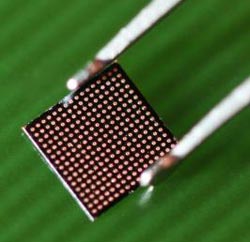Jumpstarting computers with 3-D chips

The chip is composed of three or more processors that are stacked vertically and connected together -- resulting in increased speed and multitasking, more memory and calculating power, better functionality and wireless connectivity. Credit: EPFL / Alain Herzog<br>
EPFL scientist are among the leaders in the race to develop an industry-ready prototype of a 3D chip as well as a high-performance and reliable manufacturing method.
The chip is composed of three or more processors that are stacked vertically and connected together—resulting in increased speed and multitasking, more memory and calculating power, better functionality and wireless connectivity.
Developed at the Microelectronics Systems Laboratory (LSM), Director Yusuf Leblebici is unveiling these results to experts on Wednesday the 25th of January in Paris, in a keynote presentation at the 2012 Interconnection Network Architectures Workshop.
“It's the logical next step in electronics development, because it allows a large increase in terms of efficiency,” says Leblebici.
Up to this point, chips could only be assembled horizontally via connections along their edges. Here, they are connected vertically by several hundred very thin copper microtubes. These wires pass through tiny openings, called Through-Silicon-Vias (TSV), made in the core of the silicon layer of each chip.
“This superposition reduces the distance between circuits, and thus considerably improves the speed of data exchange,” explains LSM researcher Yuksel Temiz, who is doing his PhD thesis on the subject.
To reach this result, the team had to overcome a number of difficulties, such as the fragility of the copper connections and supports which, because they are miniaturized to such an extreme degree (about 50 micrometers in thickness), are as thin as a human hair. “In three years of work, we made and tested thousands of TSV connections, and had more than 900 functioning simultaneously,” says Leblebici. “Now we have a production process that is really efficient.” He adds that the laboratory has also manufactured 3D multi-core processors, connected by a TSV network.
This technology will initially be made available to a number of academic research teams for further development, before being commercialized.
VIDEO: http://www.youtube.com/watch?v=x3z-O8rrQis
Contacts:
Yusuf Leblebici, yusuf.leblebici@epfl.ch,
tel. +41 21 693 69 51 or +41 21 693 69 55
Yuksel Temiz, yuksel.temiz@epfl.ch,
tel. +41 21 693 69 28 or +41 78 878 62 99
Media Contact
More Information:
http://www.epfl.chAll latest news from the category: Information Technology
Here you can find a summary of innovations in the fields of information and data processing and up-to-date developments on IT equipment and hardware.
This area covers topics such as IT services, IT architectures, IT management and telecommunications.
Newest articles

Trotting robots reveal emergence of animal gait transitions
A four-legged robot trained with machine learning by EPFL researchers has learned to avoid falls by spontaneously switching between walking, trotting, and pronking – a milestone for roboticists as well…

Innovation promises to prevent power pole-top fires
Engineers in Australia have found a new way to make power-pole insulators resistant to fire and electrical sparking, promising to prevent dangerous pole-top fires and reduce blackouts. Pole-top fires pose…

Possible alternative to antibiotics produced by bacteria
Antibacterial substance from staphylococci discovered with new mechanism of action against natural competitors. Many bacteria produce substances to gain an advantage over competitors in their highly competitive natural environment. Researchers…





















